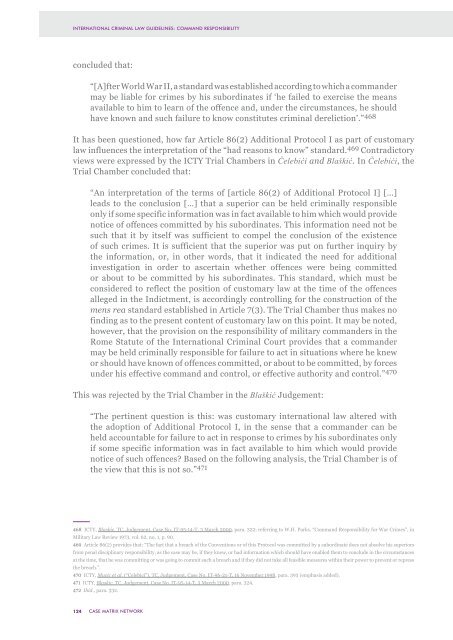Command Responsibility
CMN_ICL_Guidelines_Command_Responsibility_En
CMN_ICL_Guidelines_Command_Responsibility_En
Create successful ePaper yourself
Turn your PDF publications into a flip-book with our unique Google optimized e-Paper software.
INTERNATIONAL CRIMINAL LAW GUIDELINES: COMMAND RESPONSIBILITY<br />
concluded that:<br />
“[A]fter World War II, a standard was established according to which a commander<br />
may be liable for crimes by his subordinates if ‘he failed to exercise the means<br />
available to him to learn of the offence and, under the circumstances, he should<br />
have known and such failure to know constitutes criminal dereliction’.” 468<br />
It has been questioned, how far Article 86(2) Additional Protocol I as part of customary<br />
law influences the interpretation of the “had reasons to know” standard. 469 Contradictory<br />
views were expressed by the ICTY Trial Chambers in Čelebići and Blaškić. In Čelebići, the<br />
Trial Chamber concluded that:<br />
“An interpretation of the terms of [article 86(2) of Additional Protocol I] […]<br />
leads to the conclusion […] that a superior can be held criminally responsible<br />
only if some specific information was in fact available to him which would provide<br />
notice of offences committed by his subordinates. This information need not be<br />
such that it by itself was sufficient to compel the conclusion of the existence<br />
of such crimes. It is sufficient that the superior was put on further inquiry by<br />
the information, or, in other words, that it indicated the need for additional<br />
investigation in order to ascertain whether offences were being committed<br />
or about to be committed by his subordinates. This standard, which must be<br />
considered to reflect the position of customary law at the time of the offences<br />
alleged in the Indictment, is accordingly controlling for the construction of the<br />
mens rea standard established in Article 7(3). The Trial Chamber thus makes no<br />
finding as to the present content of customary law on this point. It may be noted,<br />
however, that the provision on the responsibility of military commanders in the<br />
Rome Statute of the International Criminal Court provides that a commander<br />
may be held criminally responsible for failure to act in situations where he knew<br />
or should have known of offences committed, or about to be committed, by forces<br />
under his effective command and control, or effective authority and control.” 470<br />
This was rejected by the Trial Chamber in the Blaškić Judgement:<br />
“The pertinent question is this: was customary international law altered with<br />
the adoption of Additional Protocol I, in the sense that a commander can be<br />
held accountable for failure to act in response to crimes by his subordinates only<br />
if some specific information was in fact available to him which would provide<br />
notice of such offences? Based on the following analysis, the Trial Chamber is of<br />
the view that this is not so.” 471<br />
468 ICTY, Blaskic, TC, Judgement, Case No. IT-95-14-T, 3 March 2000, para. 322; referring to W.H. Parks, “<strong>Command</strong> <strong>Responsibility</strong> for War Crimes”, in<br />
Military Law Review 1973, vol. 62, no. 1, p. 90.<br />
469 Article 86(2) provides that: “The fact that a breach of the Conventions or of this Protocol was committed by a subordinate does not absolve his superiors<br />
from penal disciplinary responsibility, as the case may be, if they knew, or had information which should have enabled them to conclude in the circumstances<br />
at the time, that he was committing or was going to commit such a breach and if they did not take all feasible measures within their power to prevent or repress<br />
the breach.”.<br />
470 ICTY, Mucic et al. (“Celebici”), TC, Judgement, Case No. IT-96-21-T, 16 November 1998, para. 393 (emphasis added).<br />
471 ICTY, Blaskic, TC, Judgement, Case No. IT-95-14-T, 3 March 2000, para. 324.<br />
472 Ibid., para. 332.<br />
124<br />
CASE MATRIX NETWORK


